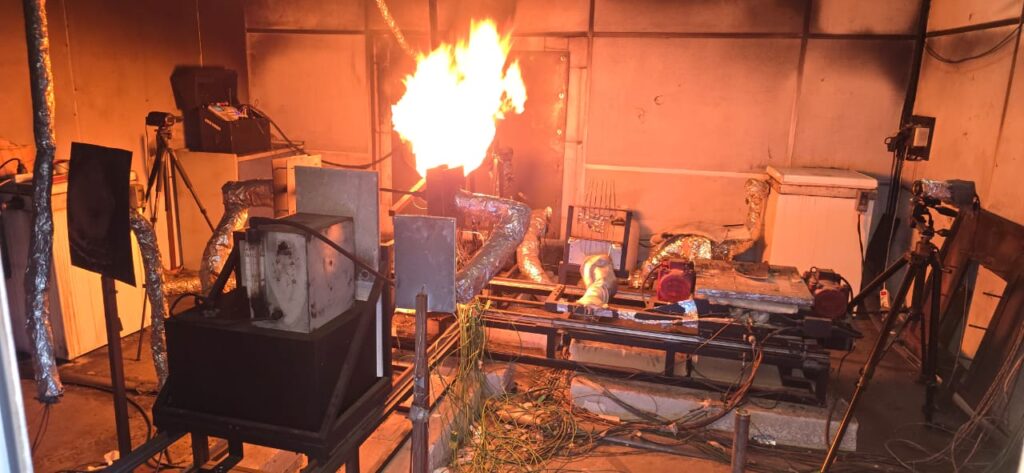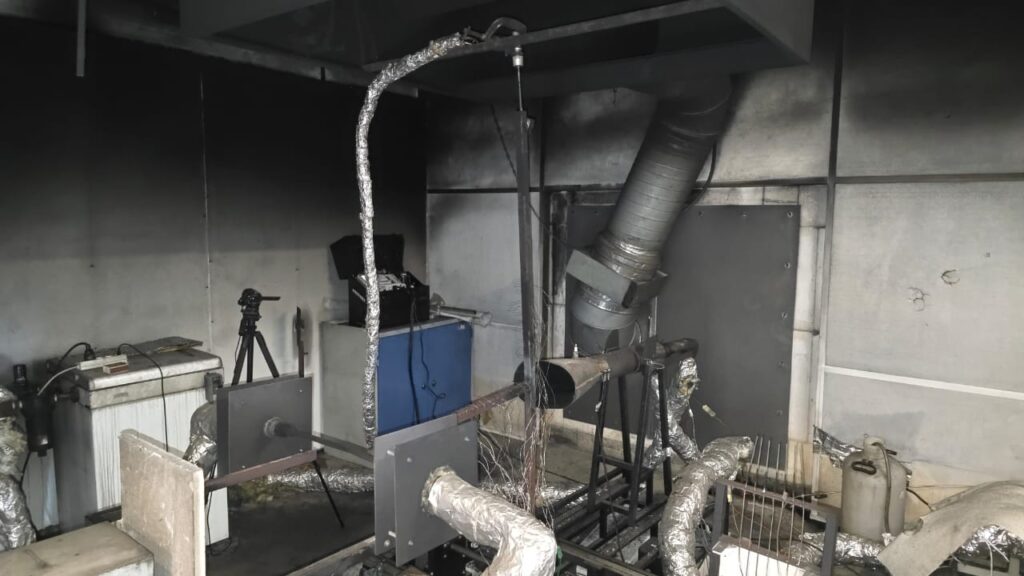By Abubakar Umar

In an era where aviation sustainability, fire safety, and renewable energy dominate global conversations, a Nigerian scientist is making waves on the global stage. He is Abdulwasiu Muhammed Raji, an indigene of Ilorin, Kwara State. He is a PhD researcher at the Institut National des Sciences Appliquées (INSA), France. INSA are specialized research universities in France. His work bridges three critical fields-fire-safe materials, sustainable aviation fuel, and biomass energy, bringing fresh solutions to global and local challenges.
Beyond the laboratory, Abdulwasiu has mentored over 1,000 students in Nigeria, Malaysia and France, a published author in leading scientific journals, and earned prestigious awards, including the Pro-Chancellor Award at Universiti Teknologi, Malaysia. His research blends technical excellence with a clear vision: to make everyday life safer, cleaner, and more sustainable.
In this interview with our Staff Correspondent, Mahmood Olayinka Alaya, he speaks about his scientific journey, groundbreaking research, and vision for Africa’s role in shaping the future of energy and safety.
- Can we meet you?
I’m Abdulwasiu Muhammed Raji. I completed my Primary education at Air Force Nursery and Primary School, Ilorin and Secondary School Education was at Kanta Unity College Argungu, Kebbi State. I earned a BSc degree from the prestigious Ahmadu Bello University (ABU), Zaria and an MSc in Polymer Technology from the Universiti Teknologi Malaysia (UTM). I am a Nigerian scientist and PhD candidate at INSA France, researching sustainable aviation fuel (SAF), combustion kinetics, and fire-safe materials. My work develops low-emission fuel blends and eco-friendly flame retardants for applications in aerospace, energy, and public safety.
Before moving to France, I served as a lecturer at Yaba College of Technology (YABATECH), Lagos, since 2014, where I taught and mentored over 1000 students in materials science, foam technology, and materials testing. I remain committed to building scientific capacity in Nigeria through education, mentorship, and collaborative research.
My research has been published in Journal of Cellular Plastics, eXPRESS Polymer Letters, Fuel, Sustainable Energy & Fuels, Renewable and Sustainable Energy Reviews, and others. I also serve as a peer reviewer for over 10 local and international journals across Elsevier, Wiley, Springer, and ACS publishers, and I’m a member of TRAN, PIN, AIAA, ASTM International, and the International Association for Fire Safety Science.
I am passionate about using science to solve real-world problems and bridge innovation between Africa and the global research community.
- What inspired your journey into researching safer and greener materials?
My journey began during my undergraduate studies in Textile Science & Technology (now known as Polymer and Textile Engineering) at ABU, Zaria, where I first became fascinated to how materials influence safety and performance in everyday life. That interest deepened during my MSc in Polymer Technology at Universiti Teknologi, Malaysia, where I led research on eco-friendly flame-retardant systems for polyurethane foams. I saw firsthand how traditional flame retardants, while effective, often posed environmental and health risks. This pushed me toward greener, safer alternatives.
Later, as a lecturer at Yaba College of Technology, I realised the importance of transferring that knowledge to the next generation, especially in contexts like Nigeria, where fire safety, material performance and material sustainability are pressing issues. Today, in my PhD at INSA France, my work focuses on sustainable aviation fuel and advanced combustion analysis. Across all stages of my career, the motivation has remained the same: to create materials that protect people, preserve the environment, and perform under real-world conditions.
- Many people hear flame retardant or biofuel and think of complex chemistry. How would you explain the real-world impact of your research to the average person?
I always say this: my research is about making everyday life safer and cleaner without people needing to think about it.
When I worked on flame-retardant materials during my MSc and academic career at YABATECH, the goal was simple: to develop foams used in furniture, insulation, or transport that don’t easily ‘catch’ fire, and when they do, release less smoke and toxic gas. That kind of material can save lives during a fire without harming the environment.

Now, in my PhD at INSA France, I focus on sustainable aviation fuel, i.e., biofuel made from plants and waste oil that can power aeroplanes but with far less pollution than traditional petroleum jet fuel. My job is to test and model this fuel, so it burns efficiently and safely.
In short, my work helps create materials that protect people from fire hazard and reduce the emission harming our planet, all while supporting industries such as aviation and construction.
- Your work spans fire safety, sustainable aviation fuel, and biomass. What unites these seemingly different areas of study?
At first glance, these fields may seem different. However, they are all connected by one central theme: how materials behave under heat, and how we can harness or control that behaviour for safety, sustainability, and performance.
From my early research on flame-retardant foams during my MSc in Malaysia, to my work as a lecturer at YABATECH, and now in my PhD at INSA France, I have always focused on thermal behaviour, whether it is preventing materials from burning, or optimising how biofuel combusts to reduce emission.
Even in my biomass research, I studied how some African tropical woods in Gabon and Nigeria transfer and store heat, to turn them into efficient, clean energy sources.
So, what unites these areas is a deep understanding of materials behaviour when heated, using science to make fuel cleaner, materials safer, and energy systems more sustainable for real-world use.
- In fire safety, what makes your flame-retardant formulation different from conventional ones, especially in terms of health and the environment?
Traditional flame retardant, especially halogenated compounds containing chlorine and bromine, releases toxic fume with persistent pollutants during fire or degradation, posing long-term risks to both human health and the environment.
What sets my formulation apart is the use of a halogen-free intumescent flame retardant (IFR) system made from ammonium polyphosphate, sepiolite nanoclay, and melamine. Sepiolite is a naturally occurring, non-toxic clay that acts as a carbonising agent, improving char stability during combustion. This structure not only slows the fire but also reduces smoke and heat release.
From our study, a specific IFR composition (16 phr, 1:2:1 ratio) achieved a high Limiting Oxygen Index (LOI) and earned a UL-94 V-0 rating, indicating excellent flame resistance. SEM analysis also showed a more stable and compact cell structure, which helps maintain insulation performance.
In short, my formulation offers superior fire protection without the environmental trade-off of conventional systems, making them ideal for safe, sustainable insulation and foam application.
- Why is your research particularly significant for developing countries like Nigeria?
My research directly addresses two critical challenges facing Nigeria: fire safety in buildings and transport, and access to cleaner, affordable energy alternatives.
In fire safety, many materials used in homes, public transport, and informal buildings in Nigeria lack proper flame retardancy, increasing the risk of deadly fires. My work on eco-friendly flame-retardant polyurethane foams provides a safer, low-smoke alternative that can be used in insulation and furniture, especially in densely populated areas.

In energy, my current PhD research on sustainable aviation fuel (SAF) and thermal analysis of biomass explores ways to reduce dependence on fossil fuel by using locally available feedstock such as plant oil from Jatropha, and agricultural waste (these are in abundant in major cities of Lagos, Kano, Sokoto, and Port Harcourt). This opens opportunities for local biofuel industries, job creation, and energy diversification.
Overall, my research is not just lab-based; it is practical, scalable, and deeply relevant to Nigeria’s development needs in safety, sustainability, and self-reliance.
- What has been the most rewarding recognition or milestone in your scientific career so far?
One of the most rewarding moments in my scientific journey was being honoured with the Pro-Chancellor Award and named the Best Master’s Student at Universiti Teknologi Malaysia (UTM), conferred during the UTM 65th convocation in May 2022. It was deeply meaningful to be internationally recognised not just for academic excellence, but also for research leadership and impact in the area of eco-friendly flame-retardant materials. Also, the school of graduate studies at UTM honoured me with a certificate of recognition for my contribution to research excellence in my faculty.
That recognition affirmed my commitment to solving real-world problems through science, and it came while conducting research on sustainable, halogen-free fire safety systems, which laid the foundation for my PhD work.
In addition, I won the 2022 PTDF PhD scholarship on my first attempt to further my research in France. This marked another important milestone, along with publishing in high-impact journals such as Fuel, Renewable and Sustainable Energy Review, Sustainable Energy & Fuel, Energy & Fuels, and mentoring students at YABATECH. Together, these experiences represent the impact I aim to continue making through both research and mentorship.
- You’ve worked in both Nigeria and France. How have these experiences shaped your scientific perspective?
Working in Nigeria gave me a deep appreciation for practical problem-solving, especially in environments where resources are limited, but the need for innovation is urgent. As a lecturer at Yaba College of Technology, I learned how to teach and conduct research with impact in mind, focusing on materials that are affordable, scalable, and suited to local challenges.
In France, I have been exposed to cutting-edge research infrastructure, advanced combustion labs, and international collaboration. My PhD at INSA France has deepened my expertise in sustainable aviation fuel and thermal analysis, and taught me how to apply rigorous, data-driven methodologies to global energy challenges.
Together, these experiences have shaped me into a scientist who values both local relevance and global standards. I now approach research with a dual lens: how can it meet international quality, and how can it serve the realities of my home country, Nigeria.
- Sustainable aviation fuel (SAF) is being called the “jet fuel of the future.” How does your work contribute to making cleaner skies a reality?
My research directly supports the global transition to cleaner skies by advancing our understanding of how sustainable aviation fuel (SAF) behaves under real engine conditions. While the aviation industry is embracing SAF such as HEFA (Hydroprocessed Esters and Fatty Acids), there is still limited data on how they perform thermally and during combustion compared to traditional Jet A-1 fuel.
In my current PhD work at INSA France, I have analysed the thermal stability, combustion efficiency, and chemical composition of pure Jet A-1, pure HEFA-SAF, and their blends using TGA, DSC, and GC-MS techniques. My findings show that HEFA-SAF is significantly more thermally stable and burns cleaner, with higher paraffinic content and lower soot-producing components than conventional jet fuel.
Most importantly, I identified specific blends (30/70% Jet A-1/HEFA-SAF) that offer an optimal balance between thermal resilience, energy efficiency, and ignition reliability. This contributes directly to refining international fuel standards such as ASTM D7566 and provides practical insights for commercial SAF integration.
In short, my work helps bridge the gap between lab research and flight-ready solutions, contributing to lower emission, safer fuel use, and a more sustainable future for aviation.
- What are the biggest challenges in developing biojet fuel, and what breakthroughs have you personally achieved?
One of the biggest challenges in developing biojet fuel is balancing combustion efficiency, ignition reliability, and thermal stability, while ensuring compatibility with existing jet engines. Many biofuels, though cleaner, struggle with low ignition indices, variability in feedstock quality, and sometimes do not meet the stringent standards of ASTM D7566 for aviation fuel certification.
Another challenge is the lack of comprehensive data on how blended fuel behaves under real-world thermal and combustion conditions. Without this, adoption by airlines and engine manufacturers remains slow.
In my PhD research at INSA France, I addressed these gaps by conducting detailed analyses of Jet A-1, HEFA-SAF, and their blends using TGA, DSC, and GC-MS. I discovered that pure HEFA-SAF offers superior thermal stability and cleaner combustion but has some limitations in ignition performance.
My key breakthrough was identifying a blend ratio (30/70% Jet A-1/HEFA-SAF) that optimises both thermal resilience and energy efficiency, while maintaining system compatibility. These findings not only contribute to refining SAF performance benchmarks but also support more informed SAF blending strategies for commercial aviation, especially in contexts where fuel safety and emission are top priorities.
- From your lab experiments to international conferences, how has the global scientific community responded to your SAF findings?
The response from the global scientific community has been very encouraging. My work on HEFA-derived sustainable aviation fuel (SAF) and its thermal and combustion behaviour has been well received because it addresses a critical knowledge gap in fuel performance and optimisation, particularly the balance between thermal stability, combustion efficiency, and engine compatibility.
I have presented these findings at respected international conferences such as the ISGC (International Symposium on Green Chemistry) in France and the International Colloquium on the Dynamics of Explosions and Reactive Systems (ICDERS) in Canada, where my results on blend optimisation sparked meaningful discussions about real-world SAF deployment strategies. Moreover, my work has been published in leading journals such as Fuel, Sustainable Energy & Fuel and Energy & Fuels, and I have been invited to peer review manuscripts in the same field, a strong recognition of my expertise. Also, I have received multiple invitations as a speaker for different conferences. The growing interest from researchers, journal editors, and potential collaborators shows that my findings are contributing to shaping SAF research directions globally, particularly in the push for low-emission, drop-in aviation fuel.
- Beyond the lab, how do you see your research influencing aviation policy or environmental regulation?
My research goes beyond the lab bench; it contributes directly to the evidence base needed for smarter, more sustainable aviation policy. By rigorously analysing the thermal stability, combustion efficiency, and emission behaviour of HEFA-based SAF and its blends, I provide data that can support refinement to international fuel certification standards such as ASTM D7566, which governs SAF usage in commercial aviation.
For regulators and policymakers, one of the major barriers to SAF adoption is the lack of comprehensive, real-world performance data. My work fills that gap by identifying blend ratios such as 30/70% Jet A-1/HEFA-SAF, that not only meet technical requirements but also offer practical solutions for lower emission and better fuel system compatibility.
In the long term, I see my research informing CORSIA (Carbon Offsetting and Reduction Scheme for International Aviation) compliance strategies and helping shape emission benchmarks and fuel subsidy policies, especially as more countries, including developing nations, work toward net-zero aviation goals.
- How could your biomass research help address energy poverty in African countries?
My biomass research is directly aligned with addressing energy poverty in Africa by exploring how locally available plant-based resources, such as tropical hardwoods and agricultural waste, can be transformed into efficient, affordable, and cleaner energy sources.
In a recent collaborative work with researchers at the Institut de Recherches Technologiques (IRT), Libreville, Gabon, I investigated the thermal property of tropical woods of Gabon origin and how their thermal conductivity, diffusivity, and energy content can be optimised for use in rural heating and power systems. This kind of data is critical for developing biomass cookstoves, briquettes, and small-scale combustion systems that are not only fuel-efficient but also reduce harmful smoke emission.
In regions where millions still rely on unsafe and polluting fuel for cooking and heating, my research provides a scientific foundation for scaling sustainable biomass energy technologies, using resources that are abundant, renewable, and locally sourced. Ultimately, this contributes to energy access, improved public health, and economic resilience in underserved communities.
- What challenges have you faced conducting cross-continental research, and how did you overcome them?
Conducting research across Nigeria, Malaysia, and now France has been incredibly rewarding, but it is not without challenges. One of the biggest challenges has been adapting to different scientific cultures, laboratory standards, and academic expectations. For example, during my MSc at Universiti Teknologi, Malaysia, I had to quickly learn new research protocols, advanced instrumentation, and international publication standards, all while navigating a new cultural and academic environment.
In France, the challenge shifted to high-level technical modeling, SAF certification frameworks, and managing language barriers and collaborative dynamics in a multinational lab.
Another ongoing challenge has been aligning research relevance, ensuring that my work, while globally competitive, remains applicable to the needs of Nigeria and other developing countries.
I overcame these obstacles through adaptability, proactive mentorship-seeking, and cross-cultural communication skills. I also maintained strong academic discipline, which led to recognitions such as the Pro-Chancellor Award in Malaysia and continued research success in France, so far, I have seven first-author publications as a PhD candidate.
These experiences have made me a resilient, globally minded researcher, capable of bridging innovation across continents.
- Collaboration seems central to your career. What partnerships or mentorship roles have been most meaningful to you?
Collaboration has truly shaped my scientific growth. One of the most meaningful experiences was working with the Enhanced Polymer Research Lab during my MSc at Universiti Teknologi, Malaysia, where we developed eco-friendly flame-retardant systems. That project laid the groundwork for my understanding of research that is both scientifically rigorous and environmentally responsible.
At INSA France, my current PhD has deepened that collaboration, working alongside combustion scientists, thermal analysts, and fuel specialists from across Europe, such as the Institut de Chimie des Milieux et Matériaux de Poitiers (IC2MP) at the Université de Poitiers, France, to advance research in sustainable aviation fuel. Co-authoring publications with other researchers in Malaysia, the United States of America, Gabon, and Nigeria, and presenting at international conferences has strengthened not just the science but also the relationships.
Equally important to me is mentorship. As a lecturer at YABATECH in Lagos, Nigeria, I mentored over 1000 students in materials science. Seeing former students pursue postgraduate research and international scholarships has been incredibly fulfilling. I also continue to mentor younger researchers virtually, particularly those from Africa, in research writing, publishing, and career development.
These partnerships, both in the lab and the classroom, reflect my belief that science moves forward when knowledge is shared, across borders and generations.
- Some people think sustainability and industrial innovation are at odds. How do you balance both in your work?
I see sustainability and industrial innovation not as conflicting goals, but as two sides of responsible scientific progress. The key is to design solutions that meet real-world industrial needs without compromising the environment or public health.
In my research on sustainable aviation fuel (SAF), for example, I work closely with ASTM-certified standards to ensure that cleaner fuel such as HEFA-SAF not only reduce emission, but also perform reliably in existing jet engines, which is critical for real-world aviation use. That is sustainability with industrial compatibility.
Similarly, in my previous work on flame-retardant materials, I developed halogen-free, intumescent systems that are safer to produce and use, while still meeting UL-94 V-0 fire safety standards, a benchmark in the manufacturing and construction industries.
My approach is always to find that intersection where scientific innovation, environmental responsibility, and industry performance converge. That is where real, lasting impact happens.
- What is the biggest misconception about green energy or fire safety materials today that you would like to correct?
One major misconception is that green energy and eco-friendly fire safety materials are less effective than conventional alternatives, that you are trading performance for sustainability. In reality, that is no longer true.
In my work on halogen-free flame-retardant foams, for example, we achieved a UL-94 V-0 rating and a 23% improvement in oxygen index, proving that eco-friendly systems can meet and even exceed industrial fire safety standards without toxic byproducts.
Similarly, with sustainable aviation fuel (SAF), many assume they are too weak or unstable for real-world flight. But my research has shown that certain HEFA-SAF blends, such as 50/50% and 30/70% Jet A-1/HEFA-SAF, offer enhanced thermal stability and cleaner combustion, making them viable for today’s aircraft.
So, the idea that “green means compromise” is outdated. Through careful research and innovation, we can build solutions that are both high-performing and environmentally responsible, and that is the future I and others are working toward.
- Looking ahead, what is your long-term vision for Africa’s role in shaping global energy and safety innovation?
My long-term vision is for Africa to move from being a passive consumer of global technologies to becoming a recognised driver of innovation in both sustainable energy and public safety solutions.
Africa is rich in biomass resources, human talent, and entrepreneurial energy, all the raw ingredients for leading in areas such as bioenergy, green materials, and localised safety engineering. However, we need to strengthen research infrastructure, cross-border collaboration, and policy alignment to unlock that potential.
I see my work as part of that transformation. Whether it is through my research on sustainable aviation fuel, flame-retardant materials, or biomass energy systems, my goal is to build bridges between global scientific networks and African institutions. I want to mentor researchers, co-develop homegrown technologies, and contribute to shaping evidence-based policies that prioritise both sustainability and safety.
Africa has a vital role to play, not just in adapting to the future, but in defining it.

